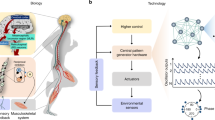Abstract
It is well known that rhythmic animal locomotive behavior such as walking, running, swimming, and flying is driven by biological neural networks with a phase-locked oscillatory behavior called a central pattern generator (CPG). This article describes a CPG circuit for the locomotion control of rhythmic robotic chewing. A two-neuron CPG model, which is slightly modified from the Matsuoka oscillator model, was implemented in a low-voltage analog CMOS circuit using the IBM 130 nm CMOS technology. A new concept of a −3 dB rhythmic chewing bandwidth has been introduced to account for the time constants in the model. The significance of the −3 dB chewing bandwidth is that any effort by the animal to chew at a faster rate than the inherent chewing bandwidth of that animal is likely to result in a reduced chewing force. Compared with the digital implementation, the analog CPG consumes less power and occupies less silicon area. The analog CPG consists of compensated current-mode low-pass filters and current mirrors implementing the neurons, which are cross-connected by inhibitory synaptic links. There are two tonic sensory inputs, two internal states, and two adaptation outputs for muscles for the CPG circuit.
Similar content being viewed by others
References
Matsuoka K (1985) Sustained oscillations generated by mutually inhibiting neurons with adaptation. Biol Cybern 52:367–376
Matsuoka K (1987) Mechanisms of frequency and pattern control in the neural rhythm generators. Biol Cybern 56(5–6):345–353
Nakada K, Asai T, Hirose T, et al (2005) Analog current-mode CMOS implementation of central pattern generator for robot locomotion. Proceedings of the IEEE International Joint Conference on Neural Networks, Montreal, Canada, IEEE, New Jersey, USA, pp 639–644
Nakada K, Asai T, Amemiya Y (2005) Analog CMOS implementation of a CNN-based locomotion controller with floating gate devices. IEEE Trans Circuits Syst I. Regular Papers 52(6):1095–1103
Nakada K, Asai T, Amemiya Y (2003) An analog CMOS central pattern generator for interlimb coordination in quadruped locomotion. IEEE Trans Neural Networks 14(5):1356–1365
Brown G (1914) On the nature of the fundamental activity of the nervous centers: together with an analysis of the conditioning of the rhythmic activity in progression, and a theory of the evolution of function in the nervous system. J Physiol 48:18–46
Taga G, Yamaguchi Y, Shimizu H (1991) Self-organized control of bi-pedal locomotion by neural oscillators in unpredictable environments. Biol Cybern 65:147–159
Williamson M (1998) Neural control of rhythmic arm movements. Neural Networks. Special issue on neural control of movements. 11:1379–1394
Kimura H, Fukuoka Y, Konaga K (2001) Adaptive dynamic walking of a quadruped robot by using a neural system model. Adv Robotics 15:859–876
Razavi B (2001) Design of analog CMOS integrated circuits. McGraw Hill, Boston
Mulder J, van der Woerd AC, Serdijn WA, et al (1997) General current mode analysis method for translinear filters C. IEEE Trans Circuits Syst I 44(3):193–197
Author information
Authors and Affiliations
Corresponding author
About this article
Cite this article
Rezaul Hasan, S.M., Xu, W.L. A central pattern generator circuit for rhythmic robotic chewing locomotion in low-voltage analog CMOS technology. Artif Life Robotics 14, 306–310 (2009). https://doi.org/10.1007/s10015-009-0749-z
Received:
Accepted:
Published:
Issue Date:
DOI: https://doi.org/10.1007/s10015-009-0749-z




